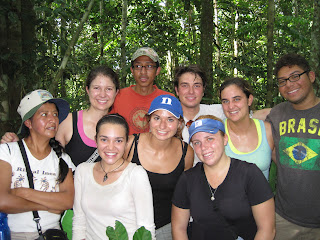Last weekend, we got to take advantage of one of the unique aspects of Ecuador and traveled with the program to the Amazon! Thursday morning we met the bus at 4:50am and spent most of the day in limbo (aka in a sleepy stupor). We arrived at Lago Agria and had lunch, which was followed by everyone's favorite-a
charla. Luckily this talk was actually interesting because it concerned
Chevron-Texaco, the oil spills, and the subsequent
case that has been going on since 1992.
After lunch we drove the remaining two hours to a river where we all piled into canoes.
 |
| The group enjoying the canoe ride |
We rode in the boats for 30 minutes through a beautiful sunset until we arrived at the
Sequoyan community, where we would be staying for two days.
The Sequoya people speak their own language, Tucanoan, and all of the kids under age nine don't even speak Spanish, only their native tongue. The entire campsite was lit with candles because there was no running electricity, although there was a toilet that sometimes flushed and a sink that sometimes worked.
 |
| Our little tent village (#wannabeK-ville) |
We quickly learned that the community was just starting their eco-tourism business and that before, they had only had groups of 5-7 people while we were a group of 25. In general, we all agreed that this made the experience much better than San Clemente, who have turned tourists into objects of money and treat the entire experience like a business. Instead, the Sequoya people were much friendlier, down to earth, and willing to share their culture with us. Although it was a little hard to sleep in the extreme humidity and heat (even at night), everyone went to sleep early.
We woke up before 6am in the morning (although I doubt anyone would want to stay in the sauna-like tents past sunrise) in order to walk through the Amazon forest in hopes of seeing pumas and monkeys. We walked along the "puma trail" for about 30 minutes and although we didn't see any animals (traveling in a group of over 25 people probably had something to do with it...), the trees and greenery were mind boggling-ly pretty and fascinating to witness.
 |
| Into the jungle! |
After breakfast, we spent the rest of the day under the shade of the main building. First we got our faces painted with berries and sticks to make us feel a little more legit.
 |
| The berries used as paint |
 |
| Cesar painting my face |
 |
| Hannah, Melody, Luis, Me, and Katie S with our painted faces |
We also received a pottery lesson using clay. from an elderly woman from the community. Although the rest of the group was mostly successful, I couldn't make a bowl or plate to save my life. Needless to say, this woman is a pro...it was so much harder than it looked!
We also made jewelry from string and little seeds from the forest that we poked holes in.
 |
| Making jewelry |
Additionally, we got to try our hand at crushing corn with a huge, heavy wooden paddle. They told us that the entire process takes over an hour! Some of the group practiced with a huge blow-dart gun, but it was so hot that I couldn't even take the two steps from under the building into the sun to try it (I'm guessing that with the heat-index, it was 110 degrees).
Throughout the entire day, several women had been preparing the cazabe (yucca that's pancake-thin). First they grated about 25 huge yuccas by hand, then squeezed the meat by hand, and then dried it again using a towel like thing to squeeze out all of the juice. Finally, they sifted the dried yucca until it looked like cheese and spread it over a large pan over a fire. The entire process literally took all day.
 |
| Front: about half of the grated yucca. Back: sifting the yucca |
 |
| Cooking the pancake-like yucca over a fire |
After chowing down, we piled into the canoes again and drove to a nearby beach on the river. Although the first day
everyone remarked about how they would never go in the water, which was dark brown and rumored to be filled with piranhas and anacondas, everyone stripped down to play in the river.
After swimming for about 30 minutes, we split up to go back to the community. I got to ride in a small wooden canoe with three other people. The ride back was extremely tranquil and we were even able to see about 20 monkeys in the trees! Apparently the other groups also saw a pink dolphin, which are endemic to the Amazon region.
Later, after dinner, we got to see another indigenous medicine ceremony by the local shaman (luckily no cuyes [guinea pigs] were harmed in the process). The shaman was dressed to impress and performed the healing ceremony on two members of the group. The process involved shaking a branch of leaves over his or her head for 20 minutes while chanting/singing in a different language. Most importantly, the shaman also smoked like a chimney and drank several glasses of rum throughout the process. Afterward, he gave them a bowl of crushed plants to drink, but I don't think he really diagnosed them.
 |
| Bethany being healed by the shaman |
Although we went to bed, the shaman continued to serenade us ALL night long while he continued to drink and heal people...




















































